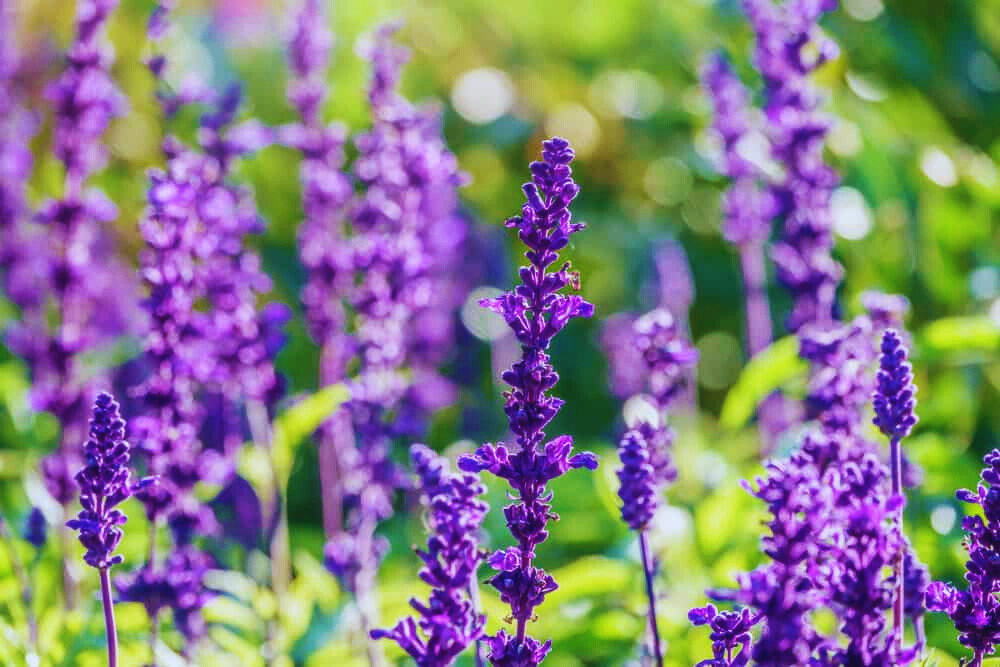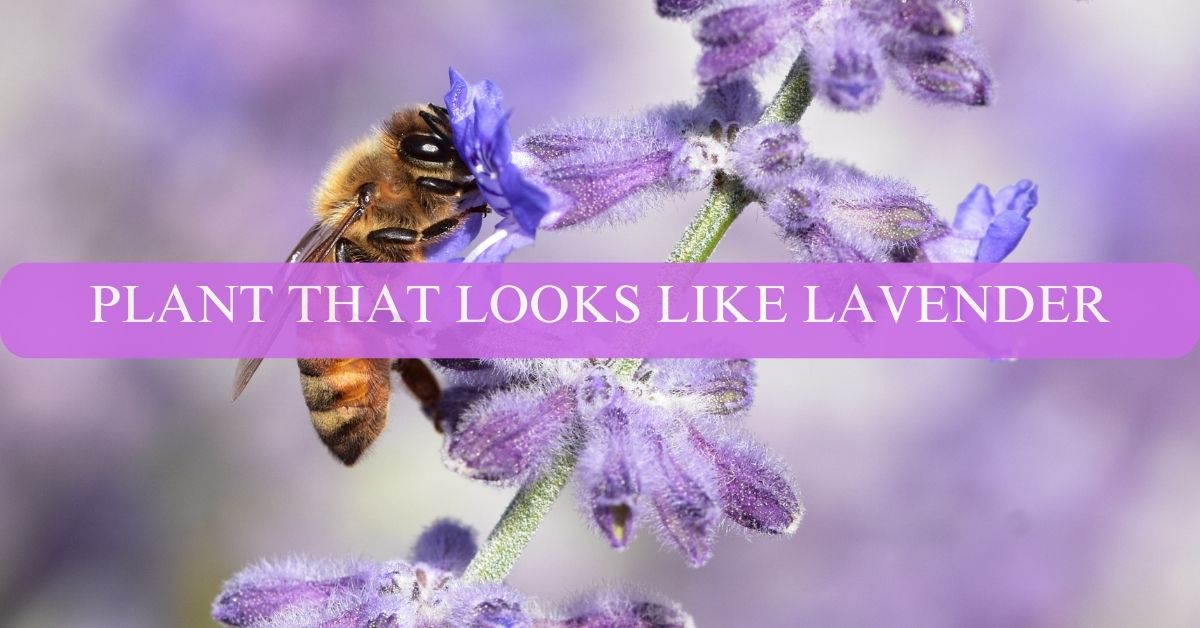Are you a fan of lavender’s soothing fragrance and captivating color?
If so, you are in for a treat!
In this article, we will unveil a collection of eight amazing plants that bear a striking resemblance to lavender, along with valuable growing tips to help you create a lavender-like oasis in your own garden.
From the vibrant hues of Russian sage to the delicate blossoms of catmint, these floral doppelgangers will certainly bewitch you with their beauty.
Get ready to explore a world where lavender isn’t the only showstopper!
But first, let’s take a glimpse at what the lavender plant looks like:

What does Lavender Looks Like?
In a word, Lavender is a stunning and enchanting plant that captures the essence of beauty and relaxation. They are typically small to medium in size, reaching an average height of about two to three feet (60 to 90 centimeters).
The lavender blossoms emerge from the stem in elegant spikes, forming clusters of tiny individual florets.
Each floret boasts a mesmerizing shade of purple, ranging from pale lavender to deep violet, and some varieties even showcase hints of pink or white. When in full bloom, the lavender field becomes a tapestry of captivating hues, evoking a sense of serenity and tranquility.
But it’s not just the colors that make lavender so captivating.
If you take a closer look, you will notice that each floret is made up of delicate petals that form a distinctive tubular shape. These petals, which are arranged in a spiral pattern, add an exquisite touch of elegance to the overall appearance of the flower.
And as you reach out to touch the lavender, you will discover a remarkable texture. The petals will feel velvety and soft, inviting you to run your fingers along their surface. Brushing against the flowers releases their essential oils, intensifying the already delightful aroma that fills the air.
And when it comes to visualizing lavender, it’s essential to consider its habitat as well. Lavender plants often flourish in sunny locations, basking in the warm embrace of sunlight.
So there you have it!
Lavender embodies nature’s elegance and grace with its slender stems, grayish-green leaves, and clusters of exquisite purple flowers. It’s a plant that delights the eyes, soothes the senses, and transports you to a world of tranquility and natural wonder.
8 Flowering Plants That Look Like Lavender to Explore!
Looking to expand your lavender-like garden oasis? These eight flowering plants are here to fulfill your desire for captivating beauty.
They are as follows:
1. Russian Sage (Perovskia Atriplicifolia)
First off, we have the Russian Sage!
This beautiful flowering plant is a real showstopper in any garden. With its silvery-green foliage and delicate lavender-colored blooms, it’s no wonder this plant has captured the hearts of many gardening enthusiasts.
Its botanical name, Perovskia Atriplicifolia, may be a bit of a tongue twister, but don’t let that intimidate you. The Russian Sage is actually quite easy to grow and care for.
This perennial plant is native to Central Asia and is well-adapted to dry and sunny conditions. Its aromatic foliage is not only visually appealing but also emits a pleasant scent when touched or brushed against. The lavender-like flowers appear in late summer and continue to bloom well into fall, adding a touch of elegance and color to your outdoor space.
Russian Sage is also a favorite among gardeners for its ability to attract pollinators like butterflies and bees. It’s like having a buzzing and fluttering orchestra in your backyard!
Another bonus is that this plant is deer-resistant, so you can enjoy its beauty without worrying about unwelcome visitors nibbling on your garden. Therefore, if you are looking to add a touch of lavender-like beauty to your landscape, Russian Sage is indeed a fantastic choice.
Growing Tips for Russian Sage
When it comes to growing Russian Sage, ensure it has enough space to spread out. It can reach a height of 3-5 feet and spread about 2-4 feet, so give it room to breathe.
This plant is fairly low-maintenance and drought-tolerant, making it an excellent choice for those who want a resilient and hassle-free addition to their garden. Pruning it back in early spring helps promote bushier growth and prevents it from becoming leggy.
2. Hummingbird Mint (Agastache Cana)
Picture this: a colorful garden filled with vibrant lavender-like flowers that seem to dance in the breeze. Well, that’s what you can expect when you introduce Hummingbird Mint, scientifically known as Agastache Cana, to your outdoor space.
This perennial herbaceous plant is a magnet for hummingbirds and other pollinators, bringing life and energy to your garden.
Hummingbird Mint, as the name suggests, attracts these tiny feathered friends with its nectar-rich blossoms. The lavender-colored flower spikes rise above the aromatic foliage, creating a visual spectacle that is hard to resist. The plant itself has a lovely, minty fragrance, making it a sensory delight to experience.
Native to the southwestern United States and Mexico, Hummingbird Mint is well-suited to warm climates and thrives in full sun and well-drained soil. It’s also a drought-tolerant plant, making it an excellent choice for those seeking low-maintenance options.
Additionally, it’s known for its resistance to pests and diseases, so you can spend less time worrying and more time enjoying its beauty.
Aside from its visual appeal and ability to attract hummingbirds, Hummingbird Mint also has culinary uses. The leaves can add a minty flavor to teas or desserts, adding a unique twist to your culinary adventures.
Growing Tips for Hummingbird Mint
To keep your Hummingbird Mint thriving, ensure it receives adequate water during its initial growth stages. As once established, it can handle drier conditions. Deadheading spent flowers promotes continuous blooming and helps maintain the plant’s overall appearance. You can also divide the plant every few years to prevent overcrowding.
3. Meadow Sage (Salvia Pratensis)
Meadow Sage is a delightful plant that mimics the lavender’s charm while showcasing its unique flair. This perennial beauty, also known as Salvia Pratensis, is a must-have for lavender lovers seeking variety in their gardens.
Meadow Sage is a hardy plant that thrives in full sun and well-drained soil, making it an excellent choice for both novice and experienced gardeners. Its vibrant blooms make a bold statement when planted in borders, cottage gardens, or even mixed perennial beds.]
You can also cut the flowers for floral arrangements, adding a touch of lavender-like elegance to your indoor spaces.
But here’s the exciting part: Meadow Sage comes in different varieties, offering a range of colors beyond the classic lavender blue. You will find selections with pink, white, or even purple flowers, allowing you to create a captivating tapestry of hues in your garden.
Growing Tips for Meadow Sage
When it comes to growing Meadow Sage, it prefers full sun (with a minimum of 6 hours of sunlight a day) and well-drained soil. This plant is relatively low-maintenance, requiring minimal watering once established.
Deadheading spent flowers will encourage continuous blooming and keep the plant looking neat and tidy. You can also consider dividing clumps every few years to promote healthy growth.
4. Catmint (Nepeta Cataria)
Catmint, scientifically known as Nepeta Cataria, is a member of the mint family and shares some similarities with its lavender cousin. It boasts aromatic gray-green foliage and produces clusters of small, tubular flowers in shades of lavender blue.
The blossoms burst into life from late spring to early summer, creating a visual feast for your garden.
Native to Europe and Asia, Catmint is known for its resilience and adaptability. It thrives in a variety of soil types and can tolerate both sun and partial shade, making it a versatile choice for any garden.
But what makes Catmint truly unique is its effect on cats.
The aroma emitted by its leaves is irresistible to feline friends, often leading them to roll, play, and lounge in the vicinity of this delightful plant. It’s like having a built-in entertainment system for your cats while enjoying the beauty of lavender-like blossoms in your garden!
Catmint is also a favorite among pollinators like bees and butterflies, adding an extra dimension of ecological benefit to your landscape. Its long-lasting blooms provide a source of nectar and pollen, attracting these winged visitors and contributing to the overall health of your garden ecosystem.
Growing Tips for Catmint
In terms of growing Catmint, it thrives in full sun to partial shade and well-draining soil. This plant is known for its resilience and ability to tolerate drought conditions, making it a low-maintenance choice for gardeners.
To keep Catmint looking tidy, you can prune it back after the first bloom to encourage fresh growth and potentially stimulate a second wave of flowers.
Native to Mexico, this plant stands out with its stunning lavender-colored flowers that resemble tiny velvet trumpets. It’s like having a miniature lavender field right in your backyard!
5. Mexican Bush Sage (Salvia Leucantha)
Mexican Bush Sage is a perennial shrub that can reach heights of up to four feet, creating an impressive focal point in any garden. Its lush green foliage serves as the perfect backdrop for the eye-catching lavender blooms, which appear from late summer through fall, extending the vibrancy of your garden well into the cooler months.
And here’s an interesting tidbit: the flowers of Mexican Bush Sage are actually made up of two parts—the outer petals that give the lavender-like appearance and the inner white petals that add a delightful touch of contrast.
What makes Mexican Bush Sage even more appealing is its ability to attract bees, butterflies, and other pollinators. It’s like hosting a lively garden party for these delightful creatures! The long, arching flower spikes sway in the breeze, creating a mesmerizing dance of color and movement.
Growing Tips for Mexican Bush Sage
When it comes to growing Mexican Bush Sage, it prefers full sun and well-drained soil. Once established, this plant is relatively drought-tolerant, making it suitable for dry climates. Regular pruning in early spring helps maintain a compact shape and promotes vigorous growth.
6. Basil (Ocimum Basilicum)
When you think of basil, your mind may conjure up images of delicious pesto or fragrant Italian cuisine. But did you know that basil is also a flowering plant that shares a striking resemblance to lavender?
Yes, you heard that right!
Basil, scientifically known as Ocimum Basilicum, offers not only culinary delights but also a touch of lavender-like beauty in your garden. While we commonly grow basil for its aromatic leaves, this herbaceous plant produces lovely lavender flowers that deserve admiration.
The delicate blooms form in clusters atop the plant’s sturdy stems and create a charming display of color. The sight of purple-hued basil flowers dancing amidst the lush green leaves is indeed a true sight to behold.
Plus, Basil is a versatile herb that is relatively easy to grow. It thrives in warm weather and requires full sun exposure to flourish. You can grow it in containers on your patio or in your garden beds.
You will have a fresh supply of aromatic leaves for your culinary adventures and be treated to the beauty of its lavender-like flowers.
So, the next time you add basil to your shopping list, consider adding a few plants to your garden as well.
After all, you will enjoy the leaves’ fragrance and flavor while marveling at the lavender-like blooms that add a touch of elegance to your outdoor space.
Get ready for a garden that’s both delicious and delightful!
Growing Tips for Basil
Growing basil is a delight for any aspiring gardener. These plants thrive in warm, sunny conditions, so find a spot in your garden where they can soak up the sun’s rays. Make sure to provide them with well-draining soil enriched with organic matter to keep them happy.
7. Wisteria
Imagine strolling through a garden where cascades of enchanting lavender-like flowers dangle from above, creating a breathtaking display. That’s the magic of Wisteria, a woody climbing vine that captures hearts with its elegant and abundant blooms.
With its long, trailing clusters of fragrant flowers, Wisteria is sure to add a touch of romance and beauty to any outdoor space. Wisteria belongs to the pea family and is renowned for its ability to create stunning floral arches and pergolas.
As the flowers unfurl, they reveal clusters of lavender, purple, or even white petals that create a dreamy atmosphere wherever they are planted. The delicate fragrance adds an extra sensory delight, inviting you to linger a little longer and savor the beauty that surrounds you.
Caring for Wisteria requires some patience and attention, as it can be a vigorous grower. But the effort is undoubtedly worth it when you witness the captivating floral display that Wisteria offers.
So, if you are looking for a flowering plant that resembles lavender but adds a touch of whimsy and drama to your garden, Wisteria is a fantastic choice. It’s like stepping into a fairytale with its graceful vines and cascades of lavender-like blossoms, creating a truly magical ambiance.
Growing Tips for Wisteria
When it comes to growing wisteria, they require a bit of patience and planning. These plants thrive in full sun and well-drained soil.
So, it’s essential to provide them with a sturdy support structure, as their vines can become quite heavy over time. Pruning is also crucial to keep them in check and encourage more prolific flowering.
8. Mealy Cup Sage (Salvia Farinacea)
Lastly, let’s explore the charming world of Mealy Cup Sage, scientifically known as Salvia Farinacea. This delightful flowering plant showcases spiky clusters of lavender-like blooms that create a sea of purple in your garden.
Native to Texas and Mexico, Mealy Cup Sage boasts long-lasting flower spikes that bloom from late spring through fall. The lavender-colored flowers are actually made up of numerous tiny florets tightly packed together, creating a dense and eye-catching display.
One of the remarkable features of Mealy Cup Sage is its ability to bloom from late spring all the way through fall, providing an extended period of floral beauty. The dense clusters of flowers add a pop of color and emit a pleasant fragrance, adding an extra sensory delight to your garden.
Caring for Mealy Cup Sage is relatively easy, making it an excellent choice for both novice and experienced gardeners. This plant prefers well-drained soil and requires regular watering to establish itself, but it becomes quite drought-tolerant once it matures.
So, whether you plant it in flower beds, containers, or borders, Mealy Cup Sage will surely steal the show. Its lavender-like flowers, abundant nectar, and delightful fragrance will not only bring joy to your garden but also will attract a myriad of pollinators, creating a vibrant and bustling ecosystem right in your backyard.
Growing Tips for Mealy Cup Sage
When it comes to growing Mealy Cup Sage, it’s all about providing the right conditions. This plant thrives in well-drained soil under full sun, just like its lavender look-alike. It’s fairly adaptable, but it prefers a bit of extra moisture during its growing season.
Regular deadheading of spent flowers will encourage continuous blooming and keep the plant looking tidy. Additionally, pruning it back in early spring can help maintain a compact shape and promote healthy growth.
FAQs
What Plant Looks Like Fuzzy Lavender?
If you’re looking for a plant that resembles fuzzy lavender, consider the Lamb’s Ear (Stachys byzantina)!
This delightful herbaceous perennial has soft, velvety leaves that feel like a cozy blanket. Besides, its silver-gray foliage creates a soothing backdrop. And when it blooms, it produces tall spikes of tiny flowers that bear a resemblance to lavender.
What Is A Purple Flowering Bush That Looks Like Lavender?
You can’t go wrong with Russian Sage when it comes to a purple flowering bush that looks like lavender. This stunning perennial shrub features delicate silver-gray foliage that sets the stage for its lavender-colored flowers. In fact, it’s a true showstopper that will make your garden come alive with its marvelous beauty.
What Does Lavender Need to Grow?
To make lavender thrive, it needs a few essentials. Lavender requires plenty of sunlight, preferably at least 6-8 hours a day, so make sure to choose a sunny spot in your garden. Well-drained soil is crucial to prevent root rot, so ensure the soil is loose and not overly compacted.
Lavender is also drought-tolerant, so it prefers infrequent deep watering rather than daily shallow watering. Finally, good air circulation is beneficial for preventing diseases and promoting healthy growth.
What Does Lavender Look Like When It Starts to Grow?
When lavender starts to grow, it emerges as small, greenish-gray shoots from the base of the plant. And as the plant matures, it develops woody stems and the iconic aromatic foliage that lavender is known for. Once it reaches its blooming stage, you will witness the emergence of the stunning lavender flowers that fill the air with their delightful fragrance.
Are Rosemary and Lavender Related Plants?
Rosemary and lavender may seem like they come from the same plant family, but they are actually not closely related. They belong to different botanical families, with rosemary belonging to the Lamiaceae family and lavender belonging to the Lamiaceae subfamily Nepetoideae.
While both plants are aromatic and herbaceous, they have distinct characteristics and growth habits. However, they often complement each other in gardens and kitchens, as they share similar preferences for sunlight, well-drained soil, and a Mediterranean-like climate.
The Bottom Line
As our botanical journey comes to a close, we hope you are inspired by the incredible array of plants that resemble lavender’s captivating beauty.
From the exquisite blooms to the aromatic scents, each plant on this list offers a unique opportunity to create a lavender-inspired haven in your own garden.
Besides, with the valuable growing tips provided, you will have all the knowledge to nurture these plants and watch them flourish.
So, what are you waiting for? Go ahead, embrace the magic of lavender-like plants, and tra


